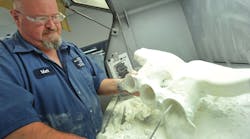Manufacturers like Ford Motor Co., Airbus, Boeing, GE Aviation continue to be high-volume buyers of metalcastings – but each one (and many others like them) has confirmed their own activity in additive manufacturing (or 3D printing.) The 3D-printed parts are not replacing castings — not yet in any case — but OEMs’ rate of progress in developing, implementing, and commercializing these in-house design and manufacturing efforts cannot be overlooked.
The American Foundry Society is not overlooking it. AFS is one of several partners in a program partly funded by the National Additive Manufacturing Innovation Institute (a federal initiative now renamed “America Makes”.) The project is titled “Accelerated Adoption of AM Technology in the American Foundry Industry,” and its agenda is to promote the transition of binder-jet AM to small metalcasting businesses by allowing increased access to the necessary equipment and developing design guidelines and process specifications.
Other participants, The ExOne Co. and Humtown Products, have had individual progress in printing sand molds, cores, and patterns. Also involved is the Youngstown Business Incubator, a coordinating body that provides facilities, equipment, resource networks, entrepreneurial counseling, networking opportunities, and other services to emerging businesses; and the University of Northern Iowa Metal Casting Center, a joint academic and commercial program that 3D-prints sand molds and cores.
Printing prototypes and patterns for engines, cylinder heads, cases, manifolds, and rotors — those are Ford’s primary AM applications. Boeing uses AM to produce patterns for exhaust ducts, while GE Aviation plans to “print” up to 40,000 fuel nozzles for its new LEAP aircraft engines, starting in 2016.
AM technology is a confluence of three scientific realms: computer, mechanical, and material engineering. Most of the progress to date has been the result of three decades of computer engineering advances; more recent breakthroughs in 3D printers and in the metals and other materials available capable of ‘printing’ are defining the applications that may challenge metalcasting.
As the effectiveness of printable metals and alloys increases — Airbus is developing a 3D-printed, hinge bracket for A320 nacelles—the competition increases with customary cast metal parts.
Recently, the Wohlers Associates consulting group reported that finished parts represented 28.3% of the $2.2 billion spent last year on 3D printing products and services.
But, the past decade saw production of finished parts grow exponentially, and that trend will continue, according to Wohlers. In its latest market study, the consultants noted that the total 3D printing market grew 28.6% to $2.204 billion in 2012, and that average annual growth over the past 25 years has been 25.4%.
3D finished products will “far surpass prototyping applications,” according to Tim Caffrey, senior consultant at Wohlers Associates, who pointed to the simple math of production: the ratio of prototypes to production parts is often 1:1,000 or greater. “The money is in manufacturing, not prototyping,” Caffrey said. “The opportunity for more commercial production activity from additive manufacturing is immense.”
“The American Foundry Society is very excited to be a partner in this project,” stated Thomas Prucha, AFS vice president-technical services and project leader for the AFS team. “Additive manufacturing is a transformative technology that not only offers reduced lead times for prototypes and new product introduction, but could revolutionize how our industry approaches low volume production and afford our members the ability to make complex shapes not producible by traditional mold and coremaking processes.”
Work associated with this new R&D effort will start in the second quarter of 2014.









